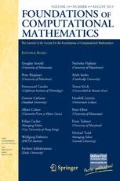Abstract
An asymptotic theory is developed for computing volumes of regions in the parameter space of a directed Gaussian graphical model that are obtained by bounding partial correlations. We study these volumes using the method of real log canonical thresholds from algebraic geometry. Our analysis involves the computation of the singular loci of correlation hypersurfaces. Statistical applications include the strong-faithfulness assumption for the PC algorithm and the quantification of confounder bias in causal inference. A detailed analysis is presented for trees, bow ties, tripartite graphs, and complete graphs.








Similar content being viewed by others
References
V. I. Arnol’d, S. M. Guseĭn-Zade and A. N. Varchenko: Singularities of Differentiable Maps, Vol. II, Birkhäuser, Boston, 1985.
S. Chaudhuri and T.S. Richardson: Using the structure of d-connecting paths as a qualitative measure of the strength of dependence, Proceedings of the Nineteenth Conference on Uncertainty in, Artificial Intelligence, pages 116–123, 2003.
D. Cox, J. Little and D. O’Shea: Ideals, Varieties and Algorithms, Springer Undergraduate Texts, Third edition, Springer Verlag, New York, 2007.
W. Decker, G.-M. Greuel, G. Pfister, and H. Schönemann: SINGULAR 3-1-5 - A computer algebra system for polynomial computations, 2012, http://www.singular.uni-kl.de.
D. Grayson and M. Stillman: MACAULAY 2, a software system for research in algebraic geometry, available at http://www.math.uiuc.edu/Macaulay2/.
M. Greenblatt: Oscillatory integral decay, sublevel set growth, and the Newton polyhedron, Math. Annalen 346, pages 857–890, 2010.
S. Greenland: Quantifying biases in causal models: classical confounding vs collider-stratification bias, Epidemiology 14, pages 300–306, 2003.
S. Greenland and J. Pearl: Adjustments and their consequences: collapsibility analysis using graphical models, International Statistical Review 79, pages 401–426, 2011.
H. Hauser: The Hironaka theorem on resolution of singularities (or: a proof that we always wanted to understand), Bull. Amer. Math. Soc. 40, pages 323–403, 2003.
H. Hironaka: Resolution of singularities of an algebraic variety over a field of characteristic zero. I, II. Ann. of Math. (2) 79, pages 109–326, 1964.
M. Kalisch and P. Bühlmann: Estimating high-dimensional directed acyclic graphs with the PC-algorithm, Journal of Machine Learning Research 8, pages 613–636, 2007.
J. Kollár: Lectures on Resolution of Singularities, Annals of Mathematics Studies 166, Princeton University Press, Princeton, NJ, 2007.
J. B. Lasserre: Level sets and non Gaussian integrals of positively homogeneous functions, International Game Theory Review. http://homepages.laas.fr/lasserre/forthcoming.html.
S. Lin: Algebraic Methods for Evaluating Integrals in Bayesian Statistics, Ph.D. dissertation, University of California, Berkeley, May 2011.
M. Marshall: Positive Polynomials and Sums of Squares, Mathematical Surveys and Monographs 146, American Mathematical Society, Providence, RI, 2008.
P. Spirtes, C. Glymour and R. Scheines: Prediction and Search, MIT Press, second edition, 2001.
C. Uhler, G. Raskutti, P. Bühlmann and B. Yu: Geometry of faithfulness assumption in causal inference, Annals of Statistics 41, pages 436–463, 2013.
S. Watanabe: Algebraic Geometry and Statistical Learning Theory, Monographs on Applied and Computational Mathematics 25, Cambridge University Press, 2009.
J. Zhang and P. Spirtes: Strong faithfulness and uniform consistency in causal inference, Uncertainty in Artificial Intelligence (UAI), pages 632–639, 2003.
J. Zhang and P. Spirtes: Detection of unfaithfulness and robust causal inference, Minds and Machines 18, pages 239–271, 2008.
Acknowledgments
This project began at the workshop Algebraic Statistics in the Alleghenies, which took place at Pennsylvania State University in June 2012. We are grateful to the organizers for a very inspiring meeting. We thank Thomas Richardson for pointing out the connection to the problem of bias reduction in causal inference. We also thank all reviewers for thoughtful comments and one of the reviewers in particular for numerous detailed comments and for spotting a mistake in a proof. This work was supported in part by the US National Science Foundation (DMS-0968882) and the Defense Advanced Research Projects Agency (DARPA) Deep Learning program (FA8650-10-C-7020).
Author information
Authors and Affiliations
Corresponding author
Additional information
Communicated by Michael Todd.
Rights and permissions
About this article
Cite this article
Lin, S., Uhler, C., Sturmfels, B. et al. Hypersurfaces and Their Singularities in Partial Correlation Testing. Found Comput Math 14, 1079–1116 (2014). https://doi.org/10.1007/s10208-014-9205-0
Received:
Revised:
Accepted:
Published:
Issue Date:
DOI: https://doi.org/10.1007/s10208-014-9205-0
Keywords
- Causal inference
- Real log canonical threshold
- Resolution of singularities
- Gaussian graphical model
- Algebraic statistics
- Singular learning theory



